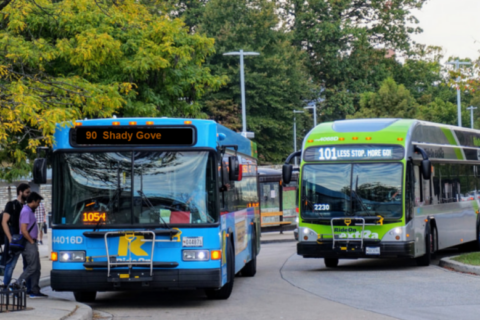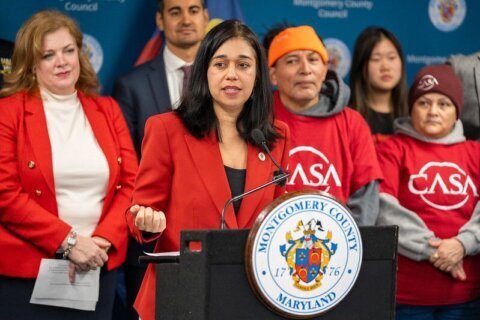Along with fighting crime, D.C.-area area police departments are struggling to fill vacant positions and retain veteran police officers.
In Montgomery County, Maryland, the problems are highlighted in a county council report prepared for the council’s Public Safety Committee.
On Monday, police Chief Marcus Jones told the committee that there are 836 positions in the patrol services bureau. Currently, he said 722 of those are filled.
“These are your first responders; these are the individuals who are answering the 911 emergency calls and that are on patrol 24 hours a day, seven days a week,” Jones said.
According to the council staff report, resignations and retirements jumped 64% in 2022. The vacancy rate among sworn officers is 10%, and more than 30% of sworn officers “are eligible for some type of retirement.”
Compounding the staffing problem, the number of people applying to become police officers has fallen 38% since 2017.
Jones said in the mid-1990s, the police department had large numbers of applicants. “Back in those days, there were recruit classes of 80,” he said.
Assistant police Chief Darren Francke told the panel, “Back when I came on 26 years ago, there were anywhere from 2,500 to 4,000 people applying for a session.”
Now he said, “Our most recent classes, we had anywhere from 300 to 400 people apply for a session, and we have many openings.” According to the report, recent recruit classes have had about 15 recruits each.
While Jones was adamant that staffing does not fall below levels for adequate coverage on patrol shifts, there have been times that detectives have been instructed to bring their uniforms to work “in order to supplement the patrol officers, should there be that need.” That happens in cases where there are events that demand a large police presence, Jones said, such demonstrations or the shooting at Magruder High School in January 2022.
Obstacles to hiring
Francke said aside from the COVID-19 pandemic, the killing of George Floyd in Minneapolis police custody and the debates over policing that followed, there are a number of obstacles to recruitment. A few, he suggested, are generational.
“We have found that our young workers have changed a bit. They look for a work-life balance, and they don’t see that in shift work all the time. They don’t see that in having to work holidays,” Francke said.
When the department was flush with applicants, the threshold on the county’s test was boosted to 70% to limit the number of applicants. But Francke said the department found that those test scores were a barrier to many applicants, particularly minority applicants.
He said the threshold has been changed to what it was before, but said, “Let me be clear on this, we are not lowering our standards. We are not lowering the standards to become a Montgomery County police officer.”
Another thing the department has found is that potential candidates can wash out in skills tests, such as driving. That too, Francke suggested, is a generational issue.
“It seems odd to say that we have people who fail driving, but the reality is these young folks, some of them have never driven before. Mom and Dad have driven them, they take public transportation or they’ve Uber-ed. They just haven’t driven a car before, let alone a big car with a big engine in it,” such as those driven by the department’s patrol division.
A long-standing issue within the department: the high cost of living in Montgomery County compared to neighboring jurisdictions. Jones told the panel that he experienced a bit of sticker shock when he came to Montgomery County from Richmond, Virginia.
“I knew it was a higher cost of living,” Jones said. “I didn’t realize it was that high!”
Jones told the committee that he estimates that about 40% of his department lives outside the county.
Recruitment efforts
“We need to recruit like we’re a Division 1 college football team, and we need to go after the best and the brightest with whatever we can,” Francke said.
Among the strategies being considered, signing bonuses, such as those used in D.C., Prince George’s County and Anne Arundel County. Francke said they appear to have been effective in the military, and “We also see results in our own backyard that it has potential.”
According to Francke, the $20,000 hiring bonus offered in Anne Arundel County has led to success in filling a recent recruit class.
Emergency communications
Another area of public safety facing hiring and retention challenges is the county’s Emergency Communications Center, where civilian staff are trained to answer all 911 and police non-emergency service calls.
According to the county council staff report, the Emergency Communication Center has 198 authorized positions. The vacancy rate is 34%, with 65 slots left open. The impact of the shortage of staffers has resulted in longer wait times for 911 and emergency lines. In the past year, the response times for emergencies has also gone up by 46 seconds, to 9 minutes and 20 seconds.
Cassandra Onley, the director of the Emergency Communications Center, told the panel that there is a need to educate the public on when to call 911.
She said that her staff handles every call that comes in and the lines can be flooded with calls that could have gone to a non-emergency number or even a different agency. But the public relies on 911 often as a first resort, perhaps because, “We don’t close. We’re always there,” Onley said.
One possible approach would be to set up a monthly Zoom with a dispatcher to educate the public on how their calls are routed and what dispatchers actually do. “Hollywood does a good job of putting out there their perception of what it is, but we don’t solve crimes,” Onley said.
Due to the high stress of the job answering frantic calls for help, a licensed social worker is on site to offer mental health support for the workers, who typically never learn how the call they responded to was resolved.
The people who handle 911 calls are “facing burnout. It’s call, after call after call,” Onley said. “The mandatory overtime is also crushing my staff.”
Currently, she said call takers have 12-hour shifts. Onley explained that staffers work, two days on, two days off, with every other weekend off.
Asked by Council member Kristin Mink how often ECC staffers are called on to work overtime, Onley answered without hesitation, “Typically every day.”
Exacerbating the short staffing, COVID-19 and staff out on medical or family leave. “Just the life stuff that happens, it is having an impact,” Onley said.
Onley said it’s important to staff up, so that employees aren’t constantly left wondering if they will once again have to stay on the job another four hours because of staffing shortages.
“Sometimes they get it because emergencies do happen,” Onley said, but the uncertainty adds to an already stressful job.
Onley said hiring and retention bonuses could be helpful in recruiting and retention efforts. She also noted that in Maryland, Montgomery County is one of two jurisdictions in which those answering 911 calls “do not have a retirement,” and are not eligible for pensions, adding that benefit could reduce the challenges in hiring.
While the county has attempted to streamline the hiring process for emergency call takers, it hasn’t solved the problem. According to the report, the county scheduled 346 applicants for testing, but 236 either withdrew their applications or were no-shows at the exam. Of the 110 who took the exam, 35 passed.








